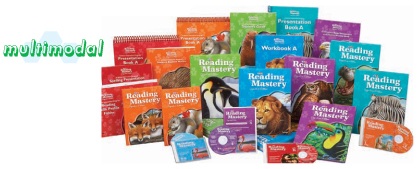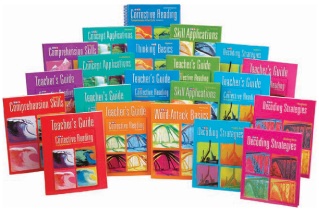Reading Program Models
READING MASTERY
DI has over 40 years of impressive history documenting its success rate. It takes a student from having learned to read, to reading to learn a variety of texts and stories. It changes from fictional stories in the early levels to nonfiction in levels 3 and 4, to reading short stories, poems, and “classics” in levels 5 and 6. It meets “Reading First” criteria, and meets or exceeds all 5 areas in reading. It increasingly emphasizes vocabulary development, which is important for more advanced classroom success in the upper levels.
 Reading Mastery Signature Edition is proven to help students decode and comprehend the meaning of print effortlessly, even students who are seriously at risk of failure. Features:
Reading Mastery Signature Edition is proven to help students decode and comprehend the meaning of print effortlessly, even students who are seriously at risk of failure. Features:
· Strategy-based instruction that allows students to learn more efficiently
· Intensive, explicit, systematic teaching to help students achieve a high rate of success
· Carefully scaffolded lessons that build confidence and independence
· Ongoing assessments and specific guidelines for remediation to help you make effective instructional decisions
· Addresses all five essential components of Reading: phonemic awareness, phonics and word analysis, fluency, vocabulary and comprehension
· Provide spelling instruction to help students make the connection between decoding and spelling patterns
Develop decoding, word recognition and comprehension skills that transfer to other subject areas
HORIZONS
Horizons is ideal for those younger students that have some letter name knowledge, but may not have adequate decoding skills or fluency rates. It accelerates reading levels and vocabulary development and is on the Reading First approved list.

Horizons is an innovative program for teaching reading that provides solid, systematic instruction using proven Direct Instruction techniques, with current research on beginning reading.
A unique instructional sequence incorporates word attack, story reading, comprehension exercises, spelling and independent work on a daily basis to ensure success. Levels A, B, and Fast Track A-B build a solid foundation for fluency and comprehension by systematically teaching phonemic awareness and phonics. Fast Track C-D expands key decoding and vocabulary skills while developing higher order thinking and comprehension strategies.
Lessons developed over six years of classroom testing provide solid, systematic instruction using proven Direct Instruction techniques, updated with current research on beginning reading. Unlike Reading Mastery, Horizons uses standard print conventions and only three orthographic prompts. This creates a need for a different sequence of beginning skills. For children who have been taught letter names, the program is very effective, as Horizons teaches a greater number of words and a broader range of skills, but requires that children be somewhat familiar with letter names.
CORRECTIVE READING PROGRAM
Corrective Reading provides intensive, sustained direct instruction to address deficiencies in decoding and comprehension.

Designed to provide differentiated personalized instruction to each learner.
A complete core program that uses:
- Two major strands and four instructional levels address a wide range of reading problems.
- The Decoding and Comprehension strands can be used separately as a supplemental reading intervention or combined for use as a comprehensive reading intervention program.
- Multiple points of entry and fast-cycle options appropriately address skill levels of students in Grades 4-Adult.
- Fully integrated assessments monitor progress and guide movement through the program.
Comprehension Strand – Select the Comprehension strand for students who need to develop vocabulary, background information, and reasoning skills that are the foundation of comprehension.
Features:
- Research-based direct instruction teaching model
- Direct teaching of critical skills and strategies to accelerate progress
- Frequent interactions between teacher and students to maximize time spent learning
- Teacher modeling and demonstration to boost student confidence and success
- Guided and independent practice and application to gradually transfer responsibility for learning
- Adequate practice and review to develop deep mastery of skills and concepts
Corrective Reading: Decoding
This program is designed for students in grades 3 and above that 1 or more years behind in reading. It is just what its name implies: corrective. It has strategies and a proven track record for improving reading performance among even the poorest of readers, and getting them to grade level. There are 4 entry points in the decoding strand. It is for students who do not read accurately or whose oral reading is choppy, as well as for less fluent readers who lack comprehension when they read. The strands range from very beginning readers with heavy emphasis on phonemic awareness and phonics, to more advanced decoders with increasing emphasis on vocabulary, comprehension, and fluency.
Corrective Reading: Comprehension Critical Thinking Skills
The Critical Thinking Skills Program teaches students a variety of thinking skills, such as analogies, statement inference, inductive and deductive reasoning, practice on auditory recall, vocabulary development, and grammar. Students learn and practice these skills both using both auditory and written practice. Students learn to pay attention to detail, take tests better, and have an overall general increase in knowledge.
|
DREAMCATCHER READING SCOPE & SEQUENCE
|
||||
|
|
GRADE 1 |
GRADE 2 |
GRADE 3 |
GRADE 4 |
| PHONICS | • Short vowels:• Voiced/unvoiced consonants
• Long vowels ea, oa, ai, silent E rule • Identifying letter names • Reading sound combinations: er, or, wh, ch, sh, qu, oo, ing • Reading irregular words: was, said, of, other, to, etc.
|
• Long Vowel review• Quotation marks
• Consonant Blends • Plurals • R-Controlled Vowels: ar, ir, ur • Inflectional Endings • Silent E review oy, oi, al, au, aw, ew • Suffixes • Contractions |
• Diphthongs• Affixes
• Consonant blends • Initial/final consonant digraphs • Vowel digraphs • Inflectional endings • Suffixes • Compound words • Syllabication ∙ Spelling difficult words
|
• Multi Syllabication• Roots
• Affixes • Suffixes • Compound words • Spelling difficult words |
| PHONEMIC AWARENESS
|
• Blending• Segmenting
• Rhyming • Pronouncing individual sounds
|
• Blending• Segmenting
• Rhyming
|
||
| FLUENCY | • Reading at an independent reading level with speed, accuracy, and intonation | • Reading at an independent reading level with speed, accuracy, and intonation | • Reading at an independent reading level with speed, accuracy, and intonation | • Reading at an independent reading level with speed, accuracy, and intonation |
| COMPREHENSION | • Retelling• Recalling details and events
• Character/setting • Fiction/Fable; • Sequencing; • Compare/Contrast; • Following written directions • Literal Cause & Effect; • Reality/Fantasy; • Main Idea: Supporting Details; • Predicting outcomes; • Relating title to story content • Inferring a character’s point of view • Pretending to be a character • Predicting narrative outcomes
|
• Main Idea• Supporting Details
• Summarizing • Using rules to classify objects • Relating title to story • Making Predictions • Compare & Contrast • Setting • Fact & Opinion • Reality/Fantasy; • Cause & Effect • Completing written deductions • Sequencing • Predicting narrative outcomes • Predicting a character’s motives
|
• Main idea• Supporting details
• Plot • Sequence • Predicting narrative outcomes • Compare & contrast • Drawing Conclusions • Fact & Opinion • Setting • Inferring story morals • Cause & Effect; • Character; • Author’s Purpose; • Predicting a character’s actions/motives |
• Main idea• Supporting details
• Plot • Sequencing • Predicting outcomes • Compare & contrast • Inference • Fact & opinion • Setting • Summarizing • Cause & effect • Character actions/traits • Author’s purpose • Identifying relevant evidence • Evaluating problems and solutions • Inference |
| VOCABULARY | • Identifying meanings• Associating pictures with words
|
• Identifying meanings• Writing names on pictures | • Identifying meanings• Comprehending definitions
• Using vocab words in context∙ • Identifying homonyms and • Homographs • Comprehending contractions |
• Identifying meanings• Comprehending definitions
• Using words in context |
|
DREAMCATCHER READING SCOPE & SEQUENCE (CONT.)
|
||||
|
|
GRADE 5 |
GRADE 6 |
GRADE 7 |
GRADE 8 |
| WORD STUDY
|
• Prefixes
• Suffixes • Roots • Syllabication |
• Prefixes
• Suffixes • Roots • Syllabication |
• Prefixes
• Suffixes • Roots • Syllabication |
• Prefixes
• Suffixes • Roots • Syllabication |
| FLUENCY | • Reading at an independent reading level with speed, accuracy, and intonation
|
• Reading at an independent reading level with speed, accuracy, and intonation | • Reading at an independent reading level with speed, accuracy, and intonation | • Reading at an independent reading level with speed, accuracy, and intonation |
| COMPREHENSION
|
• Main idea
• Supporting details • Evaluating problems/solutions • Sequencing • Predicting outcomes • Compare & contrast • Inferences • Fact & opinion • Plot • Summarizing • Cause & effect • Outlining • Drawing conclusions • Inferring story morals • Following written directions • Interpreting combined sentences • Identifying character’s traits/actions
|
• Interpreting figurative
language • Interpreting extended dialogs • Analyzing characters • Sequencing • Predicting outcomes • Compare & contrast • Inferences • Identifying relevant evidence • Identifying inferential questions • Outlining • Cause & effect • Theme • Identifying fallacies • Tone/mood • Identifying contradictions
|
• Tone & mood
• Cause & effect • Drawing conclusions • Expository text • Main idea; Supporting details • Predictions • Persuasive text • Facts & details • Character analysis • Compare & contrast • Outlining • Extended reasoning
|
• Compare & contrast
• Sequence • Main idea; Supporting details • Expository text • Tone & mood • Drawing conclusions • Inductive reasoning • Cause & effect • Facts & details • Inductive reasoning • Outlining • Identifying contradictions
|
| VOCABULARY | • Identifying meanings
• Comprehending definitions • Identifying homonyms and homographs • Using context to predict word meaning
|
• Identifying meanings
• Comprehending definitions • Using vocabulary words in context • Using context to predict word meaning
|
• Identifying meanings
• Using context to predict word meaning • Using vocabulary in context • Comprehending definitions |
• Identifying meanings
• Using context to predict word meaning • Using vocabulary in context • Comprehending definitions |

